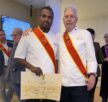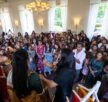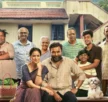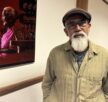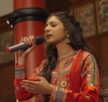

Shankar Tucker Interview
- 16th June 2011
- POST IN :UNCATEGORISED
Shankar Tucker‘s YouTube videos appear to be the latest phenomenon to hit the Internet, and his most recent upload – a cover of Tamil song "Munbe Vaa" with vocals by the Iyer Sisters – has already had over a quarter of a million views in two weeks.
Though primarily a clarinet player himself, Shankar’s music encapsulates the essence of Indian classical music, fused with hints of Western Jazz. Kavya Rajagopalan from Thamarai.com got in touch with him to find out more.
The first and most obvious question to ask is: how long have you been playing the Clarinet for? Has music always been a big part of your life?
I’ve been playing music since I was really young. My grandfather was a composer who played many different instruments: piano, bassoon, drums, and clarinet, and he started to teach me music early on. I started weekly lessons on clarinet when I was 10, and I continue to this day.
How did you become interested in Indian classical music?
I became interested in Indian classical music in High School when I heard the recordings of "Remember Shakti" by John McLaughlin. At the time I was really into Jazz and Jazz fusion, but the more I listened to these recordings, the more I realized that their brilliance was actually the Indian musical elements. I collected all the recordings of Zakir Hussain, L. Shankar, and Hariprasad Chaurasia after that. I would frequently play along with CD’s of Hariji and it became my goal to study with him one day.
During college I took lessons with a sitar teacher, Peter Row, who taught me all about the technicalities and details of Hindustani classical music. After graduating I was awarded a grant to study with Hariprasad Chaurasia for one year. I’m just finishing up that year now.
Do you find many differences in the techniques you use for Western and Indian music? How hard was it to adapt to the Indian style of music?
Adapting to the Indian style of playing had been a crazy process. The clarinet, a western instrument, is not designed to accomodate the "gamak" and "meend" that is essential to Indian music. I have spent many hours redesigning parts on my instrument to make this possible. I melted down small pieces of soft plastic polymer to replace the stiff felt pads on my clarinet, giving the instrument more resistance and a slightly more "human" feel.
"Nee Nenaindal", which has vocals by Vidya and Vanadana Iyer, is a Carnatic (South Indian Classical) piece. Do you find many differences between this and the Hindustani (North Indian Classical) style of music?
There are many differences between North and South Indian classical traditions, but there are also many similarities. In fact my teacher now, Hariprasad Chaurasia, often performs South Indian ragas and even Carnatic compositions on bansuri! Of course, he changes them slightly to fit his own style.
When I make the videos I try to minimize the differences between traditions to make the songs acceptable to either audience, North or South. I also try to balance the song with instruments and sounds. For instance, in "Nee Nenaindal" I wanted to use the combination of Tabla + Kanjira to keep the overall sound from becoming too Carnatic. Of course, I’m also using a lot of other instruments, keyboards, etc., so that helps the song from sounding too classically oriented in either tradition.
In your videos, you’re often seen playing other instruments apart from the clarinet. How many do you play in total?
I can play a handful of different instruments: tabla, kanjira, piano, bass, guitar, and clarinet. But the only instruments I know really well are clarinet and piano. The other instruments I just kind of picked up and taught myself for fun. The only reason I play so many in the videos is pure necessity. I want those instruments and sounds in a song, but I don’t have people readily available to record them for me, so I just do it on my own.
You recently recorded for Hindi film "Mausam". How did you get involved with that? Do you have more cinema recordings lined up?
Recording for "Mausam" was a lot of fun. A friend had seen one of my videos on YouTube and had played it for a sound engineer at Pritam’s studio. That guy called me in a hurry – I guess the deadline for the track was the next morning – so he asked me to come over and record that very night. I went over there in the evening, and by midnight we had a full track! The overall experience was really amazing, my first real step into the Bollywood music scene. I’m hoping to do more gigs like that in the future.
At the moment, you study with flute maestro Pandit Hariprasad Chaurasia in Mumbai. It must feel amazing to have the opportunity to be under the tutelage of such an eminent musician, right? How has that experience been so far?
Studying with Hariprasad Chaurasia has been a phenomenal experience. He is such a dedicated teacher and musician. When I first showed up and saw that he gives class everyday for almost 3 hours, I was really blown away. In the West, the standard is usually one lesson a week for one hour. This is really bringing it to a whole new level. Even though he is extremely busy with world-wide tours and playing tons of concerts, he still manages to keep a strong commitment to teaching his students. He is a truly remarkable person.
How have you been finding life in Mumbai?
Life in Mumbai is great. It is mostly just practicing, taking lessons, concerts, and recording, but that is exactly what I want. There are so many fantastic musicians in this city; I feel that there are limitless musical resources here. The lifetyle here is completely different from the U.S., but the musicians and musical opportunities make me feel right at home.
Apart from doing covers, you also write your own pieces. How would you describe your compositions, and who/what inspires you to compose?
I usually prefer to record my original compositions, but I also love the challenge of recreating a cover song and making it my own style. As far as inspiration, I often start with a raga, or maybe just a tune in my head. Or pretty much anything, it depends on the song. For instance the song I’m working now is inspired by the monsoon rains which just started in Mumbai. I would describe my compositions as somewhere in between classical Indian music and Indian folk / devotional traditions, with elements of Jazz and Popular music thrown in.
What’s next for you and your music?
I have plans to get a band together so I can start doing live shows more frequently, and hopefully get a tour together for next spring or summer. I’ve been in contact with some really phenomenal musicians, but unfortunately we are split between Chennai and Mumbai, so I’m praying that the logistics will work out. I’d also like to finish work on official album by this fall. In the meantime I’m going to keep doing videos, keep recording, and keep practicing.
You can keep up-to-date with what Shankar’s up to by checking out his YouTube channel, or via Facebook or Twitter. Also be sure to follow Thamarai.com on Twitter and join us on Facebook too!
© Thamarai.com 2011
- Previous Post
Michael Bolton & AR Rahman!


